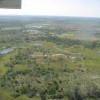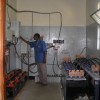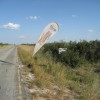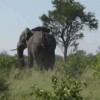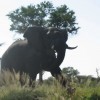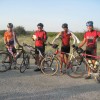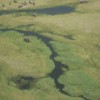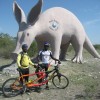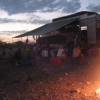BOTSWANA travel report: day 96 to 103
- Created on Wednesday, 18 April 2007 13:04
- Written by Jan Eisenloeffel
The Republic of Botswana is a landlocked nation in Southern Africa, with approximately 1.6 million people. Formerly a British protectorate, Botswana became independent within the Commonwealth on September 30, 1966. The capital and the largest city of the country is Gaborone. Botswana is predominantly flat, tending toward gently rolling tableland. The Kalahari Desert is located in the southwest of the country, and covers about 70% of the land surface of the country. The Makgadikgadi Pan, a large salt pan lies in the north. The Okavango Delta or Swamp, the world's largest inland delta, is in the northwest.
The Cubango River has no outlet to the sea. Instead, it empties onto the sands of the Kalahari Desert, irrigating 13.000 km2 of the desert. The waters of the Okavango Delta are subject to seasonal flooding, which begins about mid-summer in the north and six months later in the south (May/June). The water from the delta evaporates relatively rapidly by the high temperatures, resulting in a cycle of cresting and dropping water in the south. Islands can disappear completely during the peak flood, then reappear at the end of the season. The delta provides a seasonal habitat to numerous different species. Besides elephant, giraffe, lion, topi, etc. a type of antelope, the Lechwe, can be found in the marshy areas. They use the knee-deep water as protection from predators. Their legs are covered with water repelling substance allowing them to run quite fast in knee-deep water. The main export of Botswana is diamonds. The diamond mine in Jwaneng, the world's largest and richest mine, provides many jobs for the unemployed in Botswana. If the great demand of diamonds would decline, then the economy of Botswana would suffer greatly as they are highly dependent on this export. In 2007, significant quantities of uranium were discovered, and mining is projected to begin by 2010. Several international mining corporations have prospected in Botswana for diamonds, gold, uranium, copper, and even oil, many coming back with positive results. Due to its history and geography, Botswana has long had deep ties to the economy of South Africa. The Southern Africa Customs Union (SACU), comprising Botswana, Lesotho, Swahiland and South Africa, dates from 1910, and is the world's oldest customs union. Botswana is currently negotiating an Economic Partnership Agreement with the European Union as part of Southern African Development Community (SADC).
Wednesday April 18, Lennard and Claar sent an e-mail from Wasso.
The Wasso Hospital has one set of batteries and need three more. For this purpose Jan hopes to raise money with his cycling tour.
You can read Lennard's e-mail on the Home or Sponsor page.
!!!ELEPHANT ENCOUNTER OF THE FIRST KIND!!!
"Elephant Highway" is how the Tour d'Afrique organisation dubbed this section through Botswana because you are guaranteed to see elephants by, or crossing, the road we are cycling on from Kasane in the northeast, via Nata, to Maun in the northwest. Aside from this possibility, the ride through thinly populated Botswana is unexciting: good weather, good quality flat roads skirting the Kalahari Desert on the north and west, and importantly, mostly tailwinds that make for fast rides over the long distances (160 to 210) we need to cover daily.
On the map the Kalahari Desert seems to take up most of Botswana. Although it is called a "desert" it seems to be mostly covered by scrub, i.e. low trees and bushes. That is as seen from my bike from the road. Ideal elephant country it is said, also due to the availability of water for these large animals.
A few participants have the good fortune to spot (herds of) elephants already on the first day. All I see is a dead baby elephant by the side of the road. Later that afternoon at our bushcamp, a ranger comes by to let us know that the mother of this elephant is quite distraught, and if we sight elephants we should be extra careful. I get to see "my" elephant on the second day out of Kasane on the way to Nata. After a fast morning ride, the tandem team and I leave lunch early to get some easy distance on the fast race-peleton to then jump in as they pass us. It is not long when Joash cries "elephant crossing", and we see a huge bull come out of the scrub and cross the road a hundred meters in front of us. He towers above the road, seems three stories high, big white tusks. He looks at us as we roll closer but continues into the high grass on our side of the road. He turns his backside to us and looks over his left shoulder to see what we are doing. The tandem passes him on the road. I have taken my camera and already taken a picture as I imagine, like so many people on this trip, he doesn't like his picture taken. Then he runs at me as I roll by, trunk swaying, trumpeting loudly, flapping his ears. From my bike, ready to start sprinting, I point my camera, take a second picture, and then sprint away to safety. On the remaining two days to Maun not a single elephant is seen by me except once a whole herd crossing the road perhaps a kilometre aheas of me. However, by the time we get there nothing is to be seen anymore.
DAY 99, TEAM TIME TRIAL DAY
To break the monotony the TdA staff make day 99 to Maun a non-race day and have inserted a team time trial over 40km's. A special appeal goes out to the non-racers to participate in this event, and most do resulting in a total of 7 teams of 4 cyclists per team. The teams are put together by the staff and balanced as well as possible based on the anticipated speed of and known times of the riders. The team I am in consists of Adrie (from Holland and overall in first place), Nils (from Vancouver and at times a very strong and fast rider), Allan ( from Montreal, our eldest rider since Nairobi where he joined us), and myself (no further introduction needed). The rules are simple: start with 4 riders, ride as fast as possible to the finish 40km further, and the time is taken when the 3d rider crosses the finish line, ie. One rider can be dropped on the way.
The night before we ready our bikes for this important event. Adrie uses duct tape to tape up his back-wheel to transform it to a disc-wheel. Nils figures out a way to make our bikes sound threatening to the competition with pieces of carton duct taped to our forks with carton hitting the spokes as we ride. Allan and I transform our wheels to tri-spoke wheels also with duct tape. Allan comes with a roll of his precious toilet paper to make long streamers attached to our handle bars, saddles and helmets. We go to sleep late full of anticipation of the upcoming event. The morning breaks as usual with bright sunlight over the horizon as the teams warm-up and ready themselves for the race against the clock. Then Allan calls everyone together for the team song, clearly influenced by the toilet paper streamers, he has written overnight and proceeds to sing for us, the team joining in the refrain:
We're Team Cycle Racing and pooh,
If not racing we're on the loo,
We shit in our races,
In other teams faces,
And cry "let's go crap, let's go".
As a team our strategy is clear,
If another team looks like it's near,
We let go our load and shit in the road,
So they slip and slide in the goo,
And we cry "let's go crap, let's go".
And when our racing is through,
We sit on our communal loo,
The rafters we ring,
As our praises we sing,
And shout "let's go crap, let's go".
After the start the toilet paper wraps itself around my sprocket set and the time it takes to get rid of it makes us finish in 3d place. Allan who was the 4th man dropped off in the early stage of the race but makes a glorious come back by crossing the finish "mooning". Those Canadians!!
In Maun we have a rest day (day 100!) before continuing the long haul to the Namibian border and on to Windhoek, Namibia. Maun is the departure point for Safaris to the famous Okavango Delta and the various wildlife parks in the area. The Okavango Delta is a low lying area bordering to the northwest of Maun. Water streams yearly to it by way of the Cubango River which gets it water from the rains in Angola. By August the Delta is flooded to the maximum, and it then drains gradually into the sands below. It is a river that does not empty into an ocean! Due to the availability of water there is an abundance of wildlife in the dry season, and birds and plants to be seen that flourish in the short wet season. Due to the short time we have a number of us arrange an hours flight, at a reasonable cost, over the area in a small plane, 5 passengers plus the pilot, to at least get an idea what it all looks like. As we see from the plane, this year he delta is filling earlier than usual due to the heavy rains in the north. Elephants, giraffe, lechwe (type of gazelle in wet areas), buffalo can be seen from the air.
Days 101 to 103 are spent riding from Maun to border town Buitepos just over the border in Namibia. Long rides of 140 to 210 kilometres over uninteresting terrain. In Botswana the sun rises approximately 7:00 a.m., light enough to start cycling. To be ready I get up at about 5:15, SSS, breakfast, take down the tent and pack everything into the red box available to us for our luggage. Most of this is done in the dark by the light of a headlamp. After the 6:30 start we cycle, usually at a good clip of 30 to 33km/h, the 90km to the "lunch stop" where we arrive at say, between 9:30 and 10:00 a.m. After 30 to 45 min. we leave again to ride the remaining 70km to the finish, now often with the wind from the side or front. Here the ride becomes more competitive as riders juggle for position, and are alert to the breakaways. Because I feel good and have strong legs again, I'm able to keep up by drafting effectively and I can even take my (shorter) turns at the head of the rushing peleton which now is reduced to about 6 riders. Before the finish Adrie and Chris usually take off followed perhaps by one of the riders, but not by me. The few of us left, ride on to the finish to sprint for the honour of being 3d, 4th, 5th or 6th! We are having fun and this way the time flies by and the finish is reached between noon and 13:00 hrs. Time to eat, drink, set up the tent preferable in the shade, rest, stretch, write the log, etc. Rider meeting where the next day is discussed and dinner are at 6:00 pm. I usually retire at about 7:30 pm to my tent for a long sleep to recover from this daily routine. During the 5 days, between rest days, of this routine my cycling muscles become progressively stiffer and more exhausted as the recovery time is not sufficient at my age.
Day 103 we cross the Botswana/Namibian border to spend the night at a truck stop and camping. Two more days to Windhoek, two rest days, 5 days to AiAis in the Fish River Creek area, and then the final 7 days to Cape Town. The end of our cycle from north to south, through the African continent is nearing its end. I am in good health and spirit, I am still an E(very) F(...ing) I(nch)-er. I have seen so much of Africa, and I am overall in 4th position in the race peleton. What more could I want?
The Wasso Hospital has one set of batteries and need three more. For this purpose Jan hopes to raise money with his cycling tour.
You can read Lennard's e-mail on the Home or Sponsor page.
!!!ELEPHANT ENCOUNTER OF THE FIRST KIND!!!
"Elephant Highway" is how the Tour d'Afrique organisation dubbed this section through Botswana because you are guaranteed to see elephants by, or crossing, the road we are cycling on from Kasane in the northeast, via Nata, to Maun in the northwest. Aside from this possibility, the ride through thinly populated Botswana is unexciting: good weather, good quality flat roads skirting the Kalahari Desert on the north and west, and importantly, mostly tailwinds that make for fast rides over the long distances (160 to 210) we need to cover daily.
On the map the Kalahari Desert seems to take up most of Botswana. Although it is called a "desert" it seems to be mostly covered by scrub, i.e. low trees and bushes. That is as seen from my bike from the road. Ideal elephant country it is said, also due to the availability of water for these large animals.
A few participants have the good fortune to spot (herds of) elephants already on the first day. All I see is a dead baby elephant by the side of the road. Later that afternoon at our bushcamp, a ranger comes by to let us know that the mother of this elephant is quite distraught, and if we sight elephants we should be extra careful. I get to see "my" elephant on the second day out of Kasane on the way to Nata. After a fast morning ride, the tandem team and I leave lunch early to get some easy distance on the fast race-peleton to then jump in as they pass us. It is not long when Joash cries "elephant crossing", and we see a huge bull come out of the scrub and cross the road a hundred meters in front of us. He towers above the road, seems three stories high, big white tusks. He looks at us as we roll closer but continues into the high grass on our side of the road. He turns his backside to us and looks over his left shoulder to see what we are doing. The tandem passes him on the road. I have taken my camera and already taken a picture as I imagine, like so many people on this trip, he doesn't like his picture taken. Then he runs at me as I roll by, trunk swaying, trumpeting loudly, flapping his ears. From my bike, ready to start sprinting, I point my camera, take a second picture, and then sprint away to safety. On the remaining two days to Maun not a single elephant is seen by me except once a whole herd crossing the road perhaps a kilometre aheas of me. However, by the time we get there nothing is to be seen anymore.
DAY 99, TEAM TIME TRIAL DAY
To break the monotony the TdA staff make day 99 to Maun a non-race day and have inserted a team time trial over 40km's. A special appeal goes out to the non-racers to participate in this event, and most do resulting in a total of 7 teams of 4 cyclists per team. The teams are put together by the staff and balanced as well as possible based on the anticipated speed of and known times of the riders. The team I am in consists of Adrie (from Holland and overall in first place), Nils (from Vancouver and at times a very strong and fast rider), Allan ( from Montreal, our eldest rider since Nairobi where he joined us), and myself (no further introduction needed). The rules are simple: start with 4 riders, ride as fast as possible to the finish 40km further, and the time is taken when the 3d rider crosses the finish line, ie. One rider can be dropped on the way.
The night before we ready our bikes for this important event. Adrie uses duct tape to tape up his back-wheel to transform it to a disc-wheel. Nils figures out a way to make our bikes sound threatening to the competition with pieces of carton duct taped to our forks with carton hitting the spokes as we ride. Allan and I transform our wheels to tri-spoke wheels also with duct tape. Allan comes with a roll of his precious toilet paper to make long streamers attached to our handle bars, saddles and helmets. We go to sleep late full of anticipation of the upcoming event. The morning breaks as usual with bright sunlight over the horizon as the teams warm-up and ready themselves for the race against the clock. Then Allan calls everyone together for the team song, clearly influenced by the toilet paper streamers, he has written overnight and proceeds to sing for us, the team joining in the refrain:
We're Team Cycle Racing and pooh,
If not racing we're on the loo,
We shit in our races,
In other teams faces,
And cry "let's go crap, let's go".
As a team our strategy is clear,
If another team looks like it's near,
We let go our load and shit in the road,
So they slip and slide in the goo,
And we cry "let's go crap, let's go".
And when our racing is through,
We sit on our communal loo,
The rafters we ring,
As our praises we sing,
And shout "let's go crap, let's go".
After the start the toilet paper wraps itself around my sprocket set and the time it takes to get rid of it makes us finish in 3d place. Allan who was the 4th man dropped off in the early stage of the race but makes a glorious come back by crossing the finish "mooning". Those Canadians!!
In Maun we have a rest day (day 100!) before continuing the long haul to the Namibian border and on to Windhoek, Namibia. Maun is the departure point for Safaris to the famous Okavango Delta and the various wildlife parks in the area. The Okavango Delta is a low lying area bordering to the northwest of Maun. Water streams yearly to it by way of the Cubango River which gets it water from the rains in Angola. By August the Delta is flooded to the maximum, and it then drains gradually into the sands below. It is a river that does not empty into an ocean! Due to the availability of water there is an abundance of wildlife in the dry season, and birds and plants to be seen that flourish in the short wet season. Due to the short time we have a number of us arrange an hours flight, at a reasonable cost, over the area in a small plane, 5 passengers plus the pilot, to at least get an idea what it all looks like. As we see from the plane, this year he delta is filling earlier than usual due to the heavy rains in the north. Elephants, giraffe, lechwe (type of gazelle in wet areas), buffalo can be seen from the air.
Days 101 to 103 are spent riding from Maun to border town Buitepos just over the border in Namibia. Long rides of 140 to 210 kilometres over uninteresting terrain. In Botswana the sun rises approximately 7:00 a.m., light enough to start cycling. To be ready I get up at about 5:15, SSS, breakfast, take down the tent and pack everything into the red box available to us for our luggage. Most of this is done in the dark by the light of a headlamp. After the 6:30 start we cycle, usually at a good clip of 30 to 33km/h, the 90km to the "lunch stop" where we arrive at say, between 9:30 and 10:00 a.m. After 30 to 45 min. we leave again to ride the remaining 70km to the finish, now often with the wind from the side or front. Here the ride becomes more competitive as riders juggle for position, and are alert to the breakaways. Because I feel good and have strong legs again, I'm able to keep up by drafting effectively and I can even take my (shorter) turns at the head of the rushing peleton which now is reduced to about 6 riders. Before the finish Adrie and Chris usually take off followed perhaps by one of the riders, but not by me. The few of us left, ride on to the finish to sprint for the honour of being 3d, 4th, 5th or 6th! We are having fun and this way the time flies by and the finish is reached between noon and 13:00 hrs. Time to eat, drink, set up the tent preferable in the shade, rest, stretch, write the log, etc. Rider meeting where the next day is discussed and dinner are at 6:00 pm. I usually retire at about 7:30 pm to my tent for a long sleep to recover from this daily routine. During the 5 days, between rest days, of this routine my cycling muscles become progressively stiffer and more exhausted as the recovery time is not sufficient at my age.
Day 103 we cross the Botswana/Namibian border to spend the night at a truck stop and camping. Two more days to Windhoek, two rest days, 5 days to AiAis in the Fish River Creek area, and then the final 7 days to Cape Town. The end of our cycle from north to south, through the African continent is nearing its end. I am in good health and spirit, I am still an E(very) F(...ing) I(nch)-er. I have seen so much of Africa, and I am overall in 4th position in the race peleton. What more could I want?
Report from Windhoek during the Restday, Sundy, April 29.
This story about my experiences from Livingstone (Zambia) to here have come about with some effort as the ride through Botswana was long, flat, and boring through a mopnotonous landscape. We had to cover long daily distances of between 150 and 210 km's. These were fast rides in the race peleton where I maintained myself well due to the absence of long climbs and finished with the first five every day even coming in third on two occasions! My routine looks as follows: get up just before five, wash, breakfast, fold up the tent, pack everything in the red box and at 6:30 the 8 or so elft over racers start. We ride at a good clip of just over 30 k/h to "lunch" after about 90k where we arrive at 9:30-ish. "lunch" is actually more like a second breakfast! After 30 to 45 minutes we take off again for the final 70k or so to the finish. Again at a good speed but now mostly with head- or side- wind with jostling for a draft position to finish between 12:00 and 13:00.
More importantly, I feel fit and strong again! The difficult period in Malawi caused by the urinary tract/bladder infection and the antibiotics taken that take a long time to to flush from your body are behond me. However, after the last 5 days of hard riding I'm "muscle tired", i.e. legs, bum and lowerback don't recuperate sufficiently during the afternoon rest and nights. The mornings I feel stiff and sore even though I do a good deal of stretching and self massage of legs and bum after the rides. These restdays will help the recovery!

